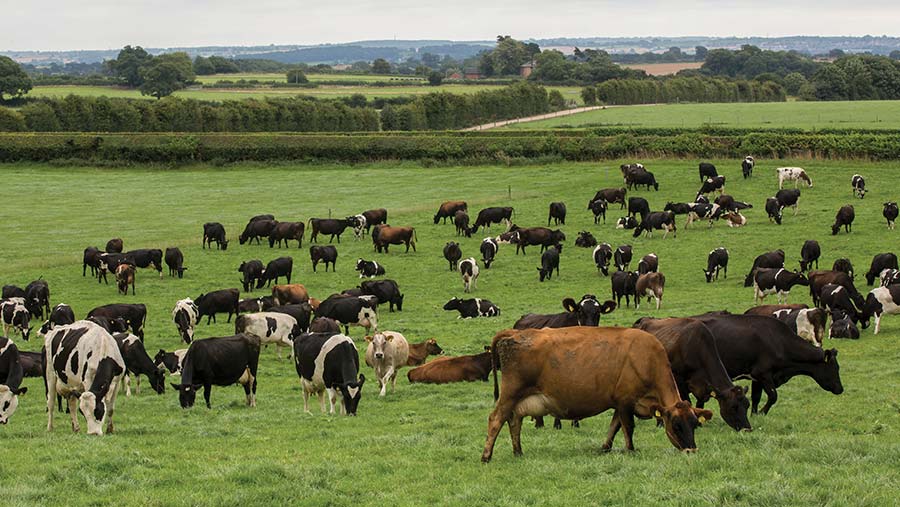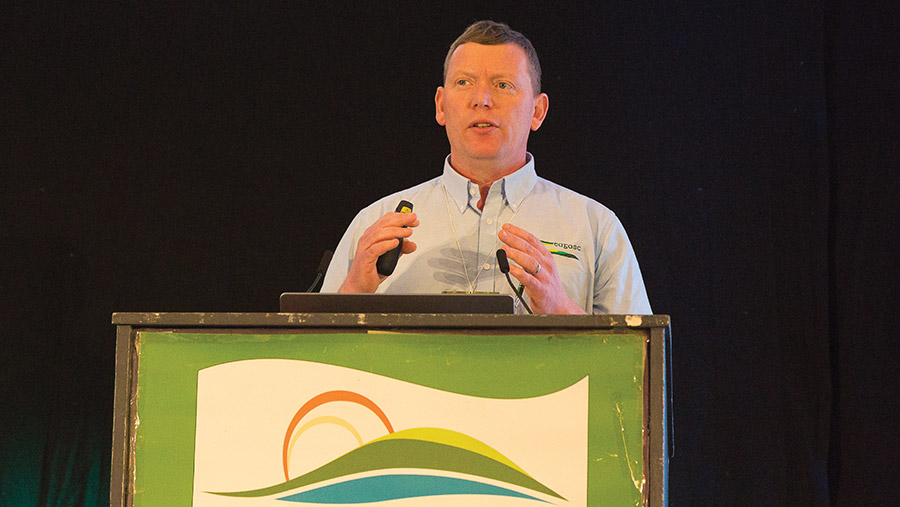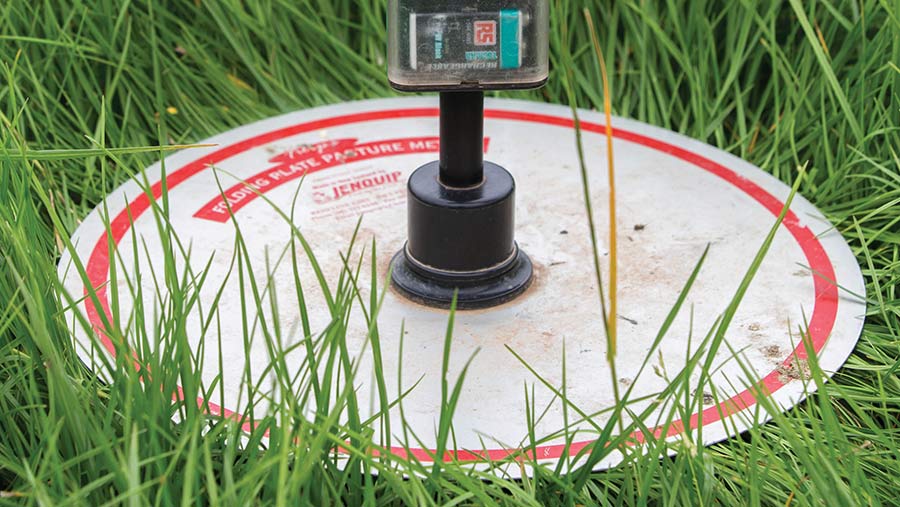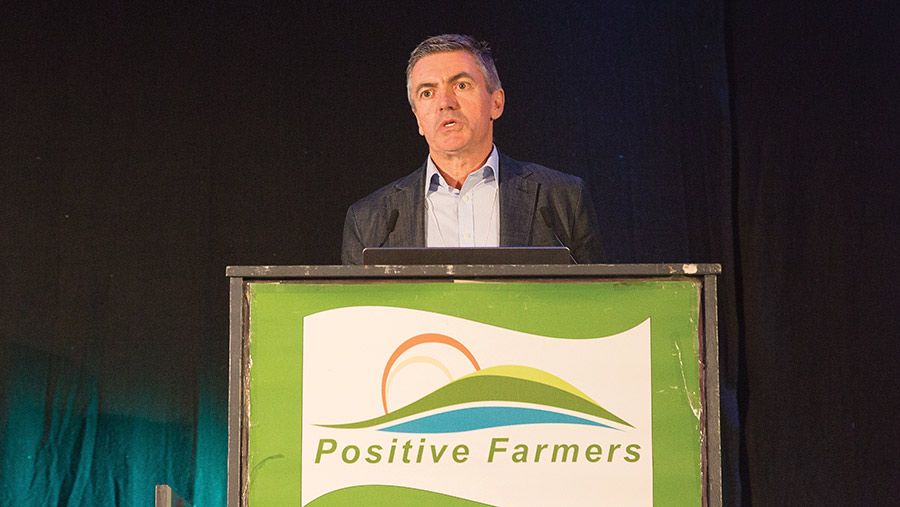Why focus on grazing basics is key to maintaining profits
 © Tim Scrivener
© Tim Scrivener Increased reliance on concentrate feeding and a decline in grass production are threatening the future profitability of Irish dairy farms.
Some of this reliance is a result of climate stresses and some from poor implementation of grazing practices, says Teagasc’s Dr Brendan Horan, principal research officer in grassland science at Moorepark.
See also: 7 tips for adopting a forage-based system from an award-winning beef producer
“There has been a step change in the cost of production, and a lot of farms will be disappointed with their 2023 returns.

Dr Brendan Horan © MAG/Judith Tooth
“Feed costs stand out: there’s been a 54% increase in feed costs on Irish farms since 2021, and alternatives to grazed pasture are increasingly unaffordable,” he says.
Overall, fewer than 5% of dairy farms are currently following best practice in grazing management (see “Grazing: What does it take to be excellent?”), he adds.
Grazing: What does it take to be excellent? |
||
|
Metric |
Detail |
Farm uptake |
|
Grazing infrastructure |
Mapped farm, two gates a paddock, water and roadways |
More than 75% |
|
Appropriate stocking rate |
Intakes above 3.5t dry matter grazed grass a cow a year |
40% |
|
Soil fertility |
More than 50% milking platform at optimum phosphorus, potassium and pH |
Less than 30% |
|
Active spring feed budget and spring rotation plan |
|
7-15% |
|
Grassland measurement |
More than 30 measures/year |
Less than 5% (762 farms) |
|
Clover-based low-chemical-N swards |
More than 25% of milking platform |
Less than 5% |
|
Source: Dr Brendan Horan (national farm surveys, nutrient management plans and PastureBase Ireland; uptake as a percentage of all dairy farms (approximately 16,000) in Ireland) |
||
The need to optimise grass use is even more important given the recent change in Ireland’s derogation from the EU Nitrates Directive.
Previously, farmers could apply up to 250kg/ha organic nitrogen a year, subject to applying additional pollution control measures.
The maximum permitted level is now 220kg/ha a year, and a possible further cut, to 170kg N/ha a year, hangs over farmers’ heads.

© Tim Scrivener
Future-proofing
Brendan lists four key requirements to future-proof farm systems:
- Increase profit (through better grass use and more grazing days/year)
- Increase efficiencies – do the basics really well
- Lower inputs and impacts (N and carbon use and loss)
- Increase carbon storage and enhance biodiversity.
DairyNZ business farm consultant Paul Bird cautions that mega-dairies in the US are incredibly efficient and can run with a cost of production below that of New Zealand and Ireland.
This means producers must keep focused on low unit cost of production to mitigate risk – and stay ahead of the game.
“It’s OK to keep bringing inputs in, as long as you get a marginal increase, but are you making extra on every increment of extra supplement? This is a very useful benchmarking exercise,” he says.
“We have a high desire to drive tractors and so on, but if you’re in a minority that’s interested in grass, you have a competitive advantage. [Similarly] if you are drawn to benchmarking, you have a competitive advantage: only 20% of NZ farmers are benchmarking and less than half of them are actively using [the results],” he says.
Simplicity
Paul suggests success is most likely when there are as few decisions as possible to make because the mind only has so much decision-making energy.
“Diverging from the average is difficult if there is no focus, or too many targets,” he says. “Complex systems also make it hard for staff to succeed.
“At some point, you may have an average manager, and you want a system where you can still get above-average results [with that manager].”
Even top operators can find it hard to keep focused during difficult periods, and morale can take a hit. Ongoing concerns about tighter environmental regulations and weather extremes are cases in point.
This makes it even more important to set up a system that can cope with fluctuation, says Paul. “Hunker down and try not to make a loss in tougher times.”
Top producers
Operating expense is one of the key drivers for a low-cost, grass-based system, with the top 25% of NZ producers spending almost NZ$1 (£0.48)/kg milk solids less than the remaining 75%.
This is according to NZ DairyBase farm data (2008-2022), says Paul.
The other key driver is pasture and crop eaten: the top 25% produce 1t DM/ha more than the rest (12.8t versus 11.8t).
There is a strong relationship between these two metrics, he adds.
On average, it results in an additional NZ$350/ha (£168) of operating profit for each extra tonne of pasture and crop eaten.
This increases to NZ$500 (£240)/ha in top milk price seasons and drops to NZ$230 (£110)/ha in the bottom milk price seasons.
“This represents a huge amount over a [working] lifetime,” says Paul.
“The flexibility and options [open to you] if you get into the top 25% increase exponentially.”
Further analysis also shows that for every NZ$100 (£48)/ha spent on supplementary feed, operating expenses increase by NZ$185 (£89)/ha.
“This is the case regardless of farm performance, ability or level of milk price,” he says.
While a farm business buying more supplements in a single season may not experience the full cost increase, over time these costs – more expensive feeding systems, more machinery and depreciation, and extra labour – tend to creep into the business, he adds.
“Whatever the infrastructure requirements, the aim should be to set the farm up really well to minimise fuss. You don’t want to overcapitalise, but you want it to run efficiently: good tracks, paddocks, water quality, slurry and milking.
“Otherwise, you waste hours and put staff – and your kids – off. Have time saving in mind.”
Dr Brendan Horan and Paul Bird were speaking at the recent 2024 Positive Farmers conference, Cork
Discipline and focus
DairyNZ business farm consultant Paul Bird says the key difference between an average grazing manager and a top one can be 1,000-1,300kg dry matter/ha of extra pasture eaten.
The top managers are focusing constantly on rotation length, pre-grazing and post-grazing cover, and average pasture cover, with clear decision rules and non-negotiable targets.

Paul Bird © MAG/Judith Tooth
“Getting grazing management right is like a fighter jet pilot coming in to land on an aircraft carrier at dusk on a stormy night, holding the controls, constantly adjusting.
The grazing manager is constantly adjusting for weather, soil moisture and temperature to hit target covers and residuals.”
Stocking rate is also critical, he says (see “Stocking rate calculation example”). Getting this right, together with rotational grazing management, results in an increase of 20-30% milk solids a hectare.
Stocking rate calculation example |
|
|
Pasture grown |
14t dry matter (DM)/ha |
|
Supplements bought in |
1.5t DM/ha |
|
Total pasture and supplements offered |
15.5t DM/ha |
|
Liveweight kg/t DM offered |
85kg (optimum comparative stocking rate for grazing systems) |
|
Liveweight/ha |
15.5 x 85 = 1,318kg liveweight/ha |
|
Source: Paul Bird |
|
“We’re in a remarkable industry where we have world-class farmers, nearly all of whom are happy to share their business.
“And if you share, too, it will make you an even better farmer. You’re missing a massive opportunity if you haven’t done that. It’s your job to get out there and copy from the best, and you’ll do exceptionally well.”
